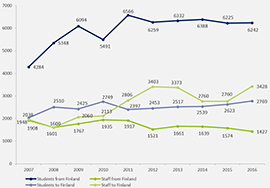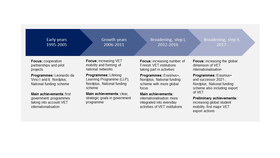Internationalisation of vocational education and training in Finland
Mika Saarinen
VET is rather attractive in Finland, with 45 per cent of the age group choosing this form of secondary education. Equally, international mobility of students, apprentices and staff in VET is very popular and has over the past ten years increased with ca. 50 per cent. This article gives an overview of the internationalisation of VET in Finland. It analyses some of the strategic steps that led to this development, and outlines some challenges and opportunities.
International mobility in Finland
Ca. 13-14 per cent of the new students and apprentices today are going on a mobility period as a part of the studies. The greatest growth in mobility took place in the years 2007-2011 and has since stabilized (cf. Figure 1). Outgoing student mobility (2016: 6,242 in) is more than double the number of incoming mobility (2016: 2,769), mainly due to a high interest and funding options, beyond also the EU-programmes, available to Finnish students. For staff mobility the situation is the reverse: incoming mobility (2016: 3,428) is more than double that of outgoing (2016: 1,427 in), one of the reasons maybe being the global interest towards Finnish education.

Finnish VET mobility is mainly taking place within Europe, both for outgoing and incoming mobility comprising some 95 per cent of all mobility. The three most popular European cooperation countries are Spain, Germany and the United Kingdom. The three biggest countries outside Europe are China, India and Japan.
But internationalisation does not limit itself to learner and staff mobility. Finnish VET providers have extensive partnerships networks throughout Europe and globally, carrying out development projects as well as cooperation around EuroSkills and WorldSkills.
Basics for the internationalisation of VET
The first strategic steps towards internationalisation can be traced back to some reports on VET in 1988-1989. In government documents during the mid-1990’s and early 2000’s there were already goals set for both growing learners and staff mobility in VET, as well as increasing partnerships outside of Europe. Targets set for the years 2011-2016 were e.g. to increase long-term student and apprentice mobility with 30 per cent and teacher and trainer mobility with 20 per cent (cf. Ministry of Education and Culture 2010).
This development always had the support of the social partners, especially the export driven Finnish industry sectors and the student unions. Particularly important for learner mobility, is that the national qualification requirements have since mid-1990’s outlined the kind of skills needed by VET learners in the area of internationalization. This has created both a basis and a demand for mobility experiences.
The rather extensive work-based learning periods in Finnish VET qualifications have allowed for qualitative and well-integrated mobility arrangements and the full inclusion of the ECVET principles in the Finnish VET-system. Student mobility thus is fully recognised.
A major tool for the internationalisation of VET institutions has been the requirement to have an institutional strategy, which has been supported by the national authorities through guides (cf. Finnish National Board of Education 2010), training programmes and surveys (cf. KORKALA 2016).
Funding programmes as the backbone of the development
The Erasmus+ and previously Leonardo da Vinci programmes have been and still are the most important funding schemes not just providing the monetary means for mobility and cooperation, but also in setting up structures and partnerships, and providing knowledge and skills to the institutions (cf. Figure 2). The autonomy of the VET institutions and their overall development into larger “knowledge and competence centres” are factors that have greatly influenced the internationalisation of these institutions.

Most recently the accreditation of VET institutions within, firstly the Leonardo da Vinci, and later the Erasmus+ programme has played a role in furthering the strategic internationalisation of VET in Finland, through providing for long-term planning in the main actions.
Especially important for the global cooperation of Finnish VET institutions has been and still is today the national funding1 provided in yearly calls, since mid-1990’s, by the Finnish National Agency for Education (EDUFI). The Nordic cooperation programme Nordplus2 , with its rather long history, plays a role in establishing, not just Nordic cooperation but also Baltic contacts.
Future outlooks
The most pressing issue for Finnish VET providers is that the VET-system as well as qualifications have undergone a major reform in 20183 , at the same time as there has been recent cuts to the national funding of VET. The reform will allow for more individualisation, flexibility and more versatile learning environments. This might in the long run increase the interest and options for mobility, despite the cuts, in the short run, having a negative impact on the ability of the VET institutions to provide own-funded mobility opportunities.
However, the potential negative consequences are expected to be short-term. The increase in the Erasmus+ funding and the potential increasing funds of the new EU-programme period 2021-2027 are favourably received in Finland, since the demand for funding is currently still much higher than the available funding on a yearly basis (ca. 73 % success rate in 2018).4 Also, new approaches to internationalisation, such as virtual cooperation, might further mitigate the effects of the cuts in national funding.
There is a growing interest towards joint qualifications of double degrees with other suitable countries, both allowing for better and more integrated long-term student mobility and more in-depth cooperation between institutions. This is work that has already taken place in sectors like hotel and tourism or business and management, but is now seemingly interesting to new sectors, such as music and art and also some technical sectors.
Export of VET training and education is increasing from Finland, and there is a growing interest in the VET qualifications and training provided by Finnish VET colleges from around the world. It is estimated that this will still keep on developing over the coming years, and have an impact on the colleges themselves, bringing yet another dimension into the international activities of Finnish VET institutions.
- 1 Cf. www.finvet.fi for more information (mainly in Finnish) (retrieved: 11.06.2018)
-
2
Cf. www.nordplusonline.org for more Information (retrieved: 11.06.2018)
-
3
For more information see http://minedu.fi/en/reform-of-vocational-upper-secondary-education (retrieved: 11.06.2018)
-
4
Finnish Erasmus+ National Agency, 2018
Literature
FINNISH NATIONAL BOARD OF EDUCATION (ed.): Strength from international cooperation – Strategic Planning for International Cooperation in Vocational Education and Training. 2010 – URL: www.cimo.fi/services/publications/strength_from_international_cooperation (retrieved: 06.06.2018)
KORKALA, S.: International dimension in the strategies and daily life of vocational schools – A survey of vocational education and training institutions in Finland, Faktaa – Facts and Figures 1B/2016 – URL: www.cimo.fi/services/publications/faktaa_1b_2016 (retrieved: 06.06.2018)
MINISTRY OF EDUCATION AND CULTURE (ed.): The Finnish Government Development Plan for Education and Research 2011-2016. 2010
MIKA SAARINEN
Counsellor of Education, Head of Section “Internationalisation services”, Finnish National Agency for Education EDUFI, Helsinki, Finland